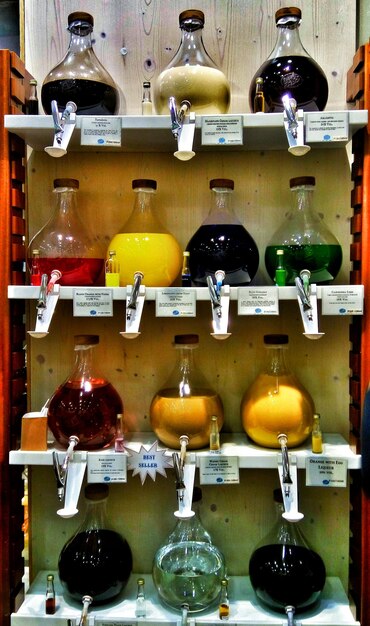Perfume Ingredients to Avoid: A Guide for Safe Choices in Germany

Advertisements
Navigating the world of fragrances requires awareness of potential irritants; this guide highlights perfume ingredients to avoid for individuals in Germany seeking safe and enjoyable scent experiences, emphasizing health, allergies, and regulatory compliance.
The allure of a captivating fragrance is undeniable, yet beneath the enchanting scents lie a complex array of ingredients. For those in Germany seeking to indulge in perfumes without compromising their health, understanding which perfume ingredients to avoid is essential. Let’s navigate this aromatic landscape together, ensuring your fragrance choices are both delightful and safe.
Advertisements
Understanding Fragrance Allergies and Sensitivities
Fragrance allergies and sensitivities are more common than many realize, impacting a significant portion of the population in Germany. It’s crucial to recognize the potential triggers in perfumes to ensure a comfortable and enjoyable experience. Understanding these sensitivities is the first step in making informed choices about the fragrances we wear.
Common Allergic Reactions to Perfumes
Allergic reactions to perfumes can manifest in various ways, ranging from mild skin irritations to more severe respiratory symptoms. Identifying these reactions is key to avoiding problematic ingredients.
- Skin Irritation: Redness, itching, and hives are common signs of contact dermatitis caused by perfume ingredients.
- Respiratory Issues: Wheezing, coughing, and difficulty breathing can occur due to inhaled allergens in fragrances.
- Headaches and Migraines: Certain synthetic fragrances are known to trigger headaches and migraines in sensitive individuals.
- Eye Irritation: Watery, itchy eyes can result from perfume ingredients coming into contact with the delicate eye area.

Advertisements
Identifying Harmful Ingredients
Many ingredients commonly found in perfumes can be harmful to sensitive individuals. Being aware of these ingredients and their potential effects is crucial for making safe choices.
Many synthetic compounds used to create unique scents, such as synthetic musks and phthalates, are known allergens and endocrine disruptors. Natural essential oils, while often perceived as safer, can also trigger allergic reactions in some individuals. Preservatives like parabens, commonly used in perfumes, can cause skin irritation and other health concerns. Dyes and colorants added for aesthetic appeal may also contain allergenic compounds. These chemicals can lead to significant reactions, especially with repeated use.
In conclusion, understanding fragrance allergies and sensitivities is paramount for enjoying perfumes safely. By recognizing the common allergic reactions and identifying potentially harmful ingredients, individuals can make informed choices that prioritize their health and well-being.
The Role of Regulations in Ensuring Perfume Safety in Germany
Germany, as part of the European Union, adheres to stringent regulations regarding the safety of cosmetic products, including perfumes. These regulations aim to protect consumers from potentially harmful ingredients and ensure transparency in product labeling. It is essential to understand how these regulations affect the perfumes available on the market.
EU Cosmetics Regulation
The EU Cosmetics Regulation (EC) No 1223/2009 sets out strict requirements for the safety and labeling of cosmetic products sold within the European Union. This regulation requires that all cosmetic products, including perfumes, undergo a safety assessment before being placed on the market.
The regulation also mandates the labeling of 26 specific fragrance allergens if they are present in a concentration of more than 0.001% in leave-on products (like perfumes) and 0.01% in rinse-off products. This labeling requirement helps consumers with known allergies avoid products that may trigger a reaction. These regulations ensure that consumers have access to safe and well-labeled products, allowing them to make informed decisions about their perfume choices.
German National Laws for Perfumes
In addition to the EU Cosmetics Regulation, Germany has its own national laws and guidelines that further regulate the perfume industry. These national regulations complement the EU framework and provide additional layers of consumer protection.
- German Food and Feed Code (LFGB): This law ensures that all products sold in Germany, including perfumes, meet specific safety standards.
- Ordinance on Cosmetic Products (KVO): This ordinance implements the EU Cosmetics Regulation at the national level and provides further details on specific requirements.
- German Federal Institute for Risk Assessment (BfR): The BfR conducts scientific assessments of the risks posed by various substances, including those used in perfumes, and provides recommendations to policymakers.

In conclusion, the regulation of perfume safety in Germany is comprehensive, combining EU-wide standards with specific national laws and guidelines. This regulatory framework aims to protect consumers from harmful ingredients and ensure that all perfumes sold in Germany meet high safety standards.
Key Ingredients to Avoid in Perfumes
When choosing perfumes in Germany, it’s crucial to be aware of specific ingredients that may pose health risks. These ingredients range from synthetic compounds to natural extracts and can cause allergic reactions, skin irritation, or other adverse effects. Educating yourself about these ingredients is essential for making informed and safe fragrance choices.
Synthetic Musks
Synthetic musks are widely used in perfumes to provide a long-lasting, base note scent. However, some synthetic musks have been identified as potential endocrine disruptors and environmental pollutants.
Common synthetic musks to avoid include: Galaxolide (HHCB), Tonalide (AHTN), and Musk Xylene. These chemicals have been shown to accumulate in the environment and in human tissues, raising concerns about their long-term health effects. Choosing perfumes that are free from these synthetic musks can help reduce your exposure to potentially harmful substances.
Phthalates
Phthalates are a group of chemicals used in perfumes to enhance the longevity of the fragrance. However, several phthalates have been linked to endocrine disruption and developmental toxicity.
The most common phthalate found in perfumes is diethyl phthalate (DEP). While some phthalates are banned in cosmetics due to their adverse health effects, DEP is still permitted in certain concentrations. To minimize your exposure to phthalates, look for perfumes labeled as “phthalate-free”.
Parabens
Parabens are preservatives commonly used in perfumes to prevent the growth of bacteria and fungi. However, parabens have been linked to endocrine disruption and potential carcinogenic effects.
Common parabens to avoid include: Methylparaben, Ethylparaben, Propylparaben, and Butylparaben. These chemicals can mimic estrogen in the body, potentially disrupting hormonal balance. Opting for perfumes that use alternative preservatives, such as natural antioxidants, can help you avoid parabens.
In conclusion, knowing key ingredients to avoid in perfumes is critical for choosing safe and healthy fragrance options. By avoiding synthetic musks, phthalates, and parabens, you can reduce your exposure to potentially harmful chemicals and protect your well-being.
Exploring Natural and Organic Perfume Alternatives
As awareness of the potential risks associated with synthetic perfume ingredients grows, many consumers in Germany are turning to natural and organic alternatives. These perfumes are formulated with natural essential oils and botanical extracts, offering a safer and more sustainable fragrance option. Exploring these alternatives can provide a delightful and health-conscious scent experience.
Benefits of Natural Perfumes
Natural perfumes offer several advantages over their synthetic counterparts. They are often made with ingredients that are less likely to cause allergic reactions or skin irritations and do not contain potentially harmful chemicals like phthalates and parabens.
- Lower Risk of Allergies: Natural perfumes typically contain fewer synthetic compounds, reducing the likelihood of allergic reactions.
- No Endocrine Disruptors: Natural perfumes avoid synthetic musks and phthalates, which are known endocrine disruptors.
- Sustainable Sourcing: Many natural perfume brands prioritize sustainable and ethical sourcing of their ingredients.
- Aromatherapeutic Benefits: Natural essential oils can offer aromatherapeutic benefits, such as relaxation and stress relief.
Popular Natural Perfume Brands in Germany
Several brands in Germany specialize in creating high-quality natural and organic perfumes. These brands are committed to using safe, sustainable ingredients and transparent labeling practices.
Brands such as Farfalla and Primavera offer a range of natural perfumes made with organic essential oils and botanical extracts. These perfumes are free from synthetic fragrances, dyes, and preservatives. Another brand, Florascent, creates traditional alcohol-based natural perfumes using a meticulous enfleurage process. These brands reflect the increasing demand for natural beauty products in Germany.
Moreover, these perfumes generally adhere to strict EU regulations, providing peace of mind regarding their composition and safety. This allows consumers to confidently navigate the fragrance market, knowing they are choosing options that support both their personal health and the environment. With a focus on transparency, these brands enable individuals to make informed purchasing decisions, aligning with their values and preferences.
How to Identify Truly Natural Perfumes
With the rise of “greenwashing,” it’s essential to be able to differentiate between truly natural perfumes and those that merely claim to be. Look for certifications from recognized organizations to ensure that the perfume meets strict standards for natural and organic ingredients.
Certifications such as NaTrue and BDIH indicate that a perfume has been formulated with natural and organic ingredients and is free from synthetic fragrances, silicones, and parabens. Check the ingredient list carefully for any hidden synthetic compounds. Additionally, research the brand’s commitment to sustainability and ethical sourcing practices. By being vigilant and informed, you can ensure that you are choosing a truly natural perfume.
In conclusion, exploring natural and organic perfume alternatives offers a safe, sustainable, and potentially therapeutic way to enjoy fragrances. By understanding the benefits of natural perfumes, researching reputable brands, and verifying certifications, you can make informed choices that align with your health and environmental values.
Decoding Perfume Labels: What to Look For
Understanding perfume labels is essential for making informed choices about the products you purchase. Perfume labels provide valuable information about the ingredients, potential allergens, and safety precautions associated with a fragrance. Learning how to decode these labels can empower you to select perfumes that are safe and suitable for your needs.
Understanding Ingredient Lists
The ingredient list on a perfume label typically includes a detailed breakdown of all the substances used to create the fragrance. It’s important to note that fragrance ingredients may be listed under the generic term “parfum” or “fragrance,” which can encompass a wide range of synthetic and natural compounds.
Pay close attention to the specific ingredients listed after “parfum” or “fragrance.” Look for known allergens, such as linalool, limonene, and geraniol, which are required to be listed if they are present in certain concentrations. Also, watch out for potentially harmful chemicals like synthetic musks, phthalates, and parabens. Being familiar with common perfume ingredients and their potential effects is crucial for interpreting ingredient lists effectively.
Identifying Allergens
The EU Cosmetics Regulation requires the labeling of 26 specific fragrance allergens if they are present in a concentration of more than 0.001% in leave-on products (like perfumes) and 0.01% in rinse-off products. These allergens are commonly found in both synthetic and natural fragrances and can cause allergic reactions in sensitive individuals.
Common fragrance allergens include: Amyl cinnamal, Benzyl alcohol, Cinnamal, Citral, Coumarin, Eugenol, Geraniol, and Limonene. Check the ingredient list carefully for these allergens, especially if you have known sensitivities or allergies. Many perfume brands also offer allergen-free or hypoallergenic perfumes for individuals with sensitive skin.
Certifications and Labels
Perfume labels may also include certifications and labels that indicate the product meets certain standards for safety, sustainability, and natural ingredients. These certifications can provide additional assurance that the perfume has been formulated with high-quality, ethically sourced ingredients.
Look for certifications such as: NaTrue, BDIH, and Ecocert. These certifications verify that the perfume has been formulated with natural and organic ingredients and is free from synthetic fragrances, silicones, and parabens. Additionally, check for labels such as “phthalate-free” and “paraben-free” to ensure that the perfume does not contain these potentially harmful chemicals.
In conclusion, decoding perfume labels is a crucial skill for making informed fragrance choices. By understanding ingredient lists, identifying allergens, and recognizing certifications, you can select perfumes that are safe, sustainable, and suitable for your individual needs.
Tips for Choosing Safe Perfumes in Germany
Selecting the right perfume can be a delightful experience. With a focus on safety, understanding perfume regulations, and knowing the ingredients to avoid, you can make informed choices that prioritize your health and well-being. This section offers tips to help you choose perfumes that are both enjoyable and safe.
Read Ingredient Lists Carefully
Before purchasing any perfume, take the time to read the ingredient list carefully. Look for any ingredients that you know you are allergic to or sensitive to. Avoid perfumes that contain synthetic musks, phthalates, and parabens.
Additionally, be aware that the term “fragrance” or “parfum” can encompass a wide range of synthetic and natural compounds. If specific ingredients are not listed, consider contacting the manufacturer for more information or choosing a perfume from a brand that prioritizes transparency.
Opt for Natural and Organic Perfumes
Natural and organic perfumes offer a safer alternative to traditional synthetic fragrances. These perfumes are formulated with natural essential oils and botanical extracts, which are less likely to cause allergic reactions or skin irritations.
- Reduced Chemical Exposure: Natural perfumes minimize your exposure to potentially harmful synthetic chemicals.
- Environmentally Friendly: Many natural perfume brands prioritize sustainable and ethical sourcing of their ingredients.
- Unique Scents: Natural essential oils offer a wide range of complex and captivating scents.
Perform a Patch Test
Before applying a new perfume to your entire body, perform a patch test to check for any allergic reactions or skin sensitivities. Apply a small amount of the perfume to a discreet area, such as the inside of your wrist or elbow, and wait 24-48 hours to see if any irritation develops.
If you experience redness, itching, or swelling at the test site, discontinue use of the perfume immediately. This precaution can help you identify potential allergens and avoid more widespread reactions.
Choosing a safe perfume involves awareness and careful selection. Be proactive in reading labels, opting for natural alternatives, and performing patch tests. These steps will help you enjoy fragrances without compromising your well-being, ensuring every scent experience is both pleasurable and safe.
| Key Point | Brief Description |
|---|---|
| ⚠️ Harmful Ingredients | Avoid synthetic musks, phthalates, and parabens for health safety. |
| 🌿 Natural Alternatives | Opt for perfumes made with essential oils and botanical extracts. |
| 📜 Read Labels | Check for allergens, certifications, and ingredient lists carefully. |
| 🧪 Patch Test | Test perfumes on a small skin area before full use to avoid reactions. |
FAQ – Safe Perfume Choices in Germany
▼
Common allergens include ingredients like linalool, limonene, and geraniol. These are required to be listed on the label by EU regulations if present above certain concentrations, helping consumers identify potential irritants.
▼
Not necessarily. While natural perfumes avoid certain synthetic chemicals, some natural essential oils can also cause allergic reactions in sensitive individuals. Always check the ingredient list carefully.
▼
“Phthalate-free” indicates that the perfume does not contain phthalates, a group of chemicals used to enhance fragrance longevity but linked to endocrine disruption and developmental toxicity issues.
▼
Look for certifications like NaTrue or BDIH, which ensure the perfume meets strict standards for natural and organic ingredients. Also, check for detailed ingredient lists avoiding synthetic compounds.
▼
A patch test helps identify potential allergic reactions before applying the perfume to your entire body, preventing widespread irritation. Apply a small amount to a discreet area and monitor for 24-48 hours.
Conclusion
In conclusion, choosing safe perfumes in Germany requires understanding potential allergens, regulations, and ingredients to avoid. By being vigilant and informed, you can enjoy fragrances that enhance your well-being without compromising your health.